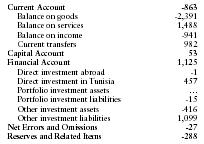Tunisia - Balance of payments
Since 1960, Tunisia has experienced perennial trade deficits. These have been partly covered by tourist income, by remittances from Tunisian workers abroad, and by foreign investment and assistance. The 8th Development Plan (1992–96) aimed at improving the balance of payments deficit from 4.2% of GDP in 1991 to 2% by 1996 by encouraging free trade, foreign direct investments, and elimination of exchange restrictions. The budget deficit declined from 4.0% of GDP in 1997, to 1.7% of GDP in 1998, due to the privatization of two cement plants. The country's trade deficit rose substantially in 2000, by nearly 20%. Imports rose 16.5%, and exports climbed 14.9%. Food exports decreased, driven by weak olive oil sales. Although textile exports still remain the country's leading source of hard currency, ready-to-wear apparel sales have fallen off in recent years. Nevertheless, high petroleum product prices made up the difference for the decline in lower-performing export sectors in the early 2000s.
The US Central Intelligence Agency (CIA) reports that in 2001 the purchasing power parity of Tunisia's exports was $6.6 billion while imports totaled $8.9 billion resulting in a trade deficit of $2.3 billion.
The International Monetary Fund (IMF) reports that in 2001 Tunisia had exports of goods totaling $6.61 billion and imports totaling $9 billion. The services credit totaled $2.91 billion and debit $1.42 billion. The following table summarizes Tunisia's balance of payments as reported by the IMF for 2001 in millions of US dollars.

| Current Account | -863 |
| Balance on goods | -2,391 |
| Balance on services | 1,488 |
| Balance on income | -941 |
| Current transfers | 982 |
| Capital Account | 53 |
| Financial Account | 1,125 |
| Direct investment abroad | -1 |
| Direct investment in Tunisia | 457 |
| Portfolio investment assets | … |
| Portfolio investment liabilities | -15 |
| Other investment assets | -416 |
| Other investment liabilities | 1,099 |
| Net Errors and Omissions | -27 |
| Reserves and Related Items | -288 |
Comment about this article, ask questions, or add new information about this topic: